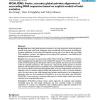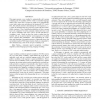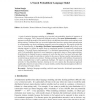175 search results - page 16 / 35 » A Probability Model to Improve Word Alignment |
RECOMB
2003
Springer
14 years 8 months ago
2003
Springer
Protein sequence alignments are more reliable the shorter the evolutionary distance. Here, we align distantly related proteins using many closely spaced intermediate sequences as ...
BMCBI
2006
13 years 7 months ago
2006
Background: Non-coding DNA sequences comprise a very large proportion of the total genomic content of mammals, most other vertebrates, many invertebrates, and most plants. Unravel...
ICASSP
2011
IEEE
12 years 11 months ago
2011
IEEE
This paper presents a new method to automatically add n-grams containing out-of-vocabulary (OOV) words to a baseline language model (LM), where these n-grams are sought to be gram...
NIPS
2000
13 years 9 months ago
2000
A goal of statistical language modeling is to learn the joint probability function of sequences of words in a language. This is intrinsically difficult because of the curse of dim...
RECOMB
2003
Springer
14 years 8 months ago
2003
Springer
In this paper, we describe a method for statistical reconstruction of haplotypes from a set of aligned SNP fragments. We consider the case of a pair of homologous human chromosome...



